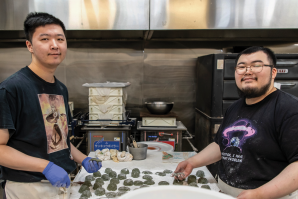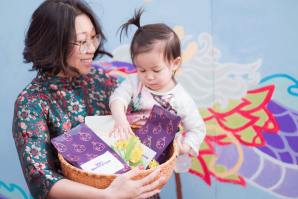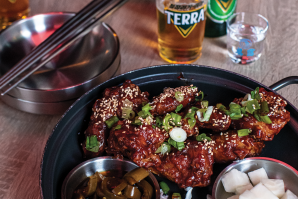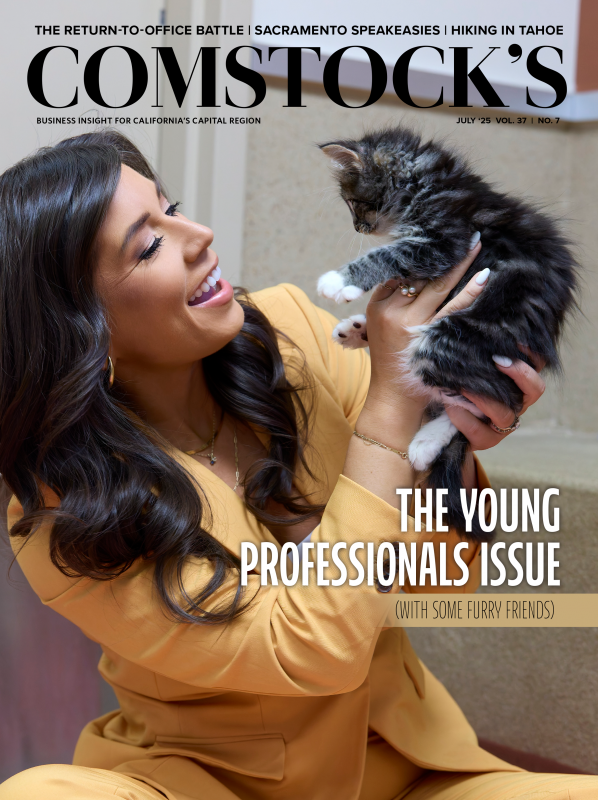Inside a brick building with walls painted white, the smell of grilled limes permeates the bar. The micheladas are rimmed with crushed blue Takis in aluminum Solo cups, and the specialty cocktail is garnished with smoked strawberries. The seating inside is made of concrete blocks gathered in circles under contemporary paintings. A DJ spins vinyl while the front lot outside is filled with dinner attendees experiencing a multi-set tasting menu provided by local chefs and restaurateurs.
This isn’t a trending bar or restaurant — it’s an art gallery.
“I needed an industrial space with an open vibe, so I contacted Demo Art and Books, and I knew they’d be interested,” says Chef Byron Hughes.
The Live Fire Cooking Club was organized by Chef Hughes of the Last Supper Club. The Last Supper Club is a dinner series that came out of the pandemic shutdowns in 2020 after his virtual events started going viral — sometimes having anywhere from 600 to 700 people joining the virtual experience.
Hughes and his partner, Mandy Lee, organized the Live Fire Cooking Club under their latest venture, Restaurant XO. The event is a collaboration with cocktail artist Andrew Calisterio and rising star Chef Marc Agtina, sponsored by Thaan Charcoal (makers of some seriously hot charcoal grills).
Are art spaces becoming the new “third places?” Originally theorized by Ray Oldenburg, a third place is meant to be a social anchor between home and work. Typically these communal places are bookstores, salons, coffeeshops, pubs and restaurants. But across Sacramento, art spaces like Demo, Panama Pottery and Forma are filling the social gap left by shuttered cafes and bars.
Taking root in the city
An estimated 30 percent of California restaurants closed after the pandemic, according to the California Restaurant Association. Meanwhile, young entrepreneurs are struggling to fill the gap. With rents rising in the region, many have trouble accessing brick and mortar spaces.
“The biggest hindrance is money. There are a lot of vacant spaces that are built out and are shell spaces. The price of rent is kind of insane. We both work in the industry, and it’s a juggling act to figure out how much time can be devoted to Kotu while we still have to survive as people,” says Lonnie Kotanko, co-founder of the pop-up Kotu Coffee. “We specifically pick spaces where people can hang out. Last year we had 22 pop-ups, and people who hadn’t met before were collaborating on art.”
Charcoal-grilled prawns were among the small plates on offer at
the Live Fire pop-up.

Daniel Tutupoly, Lonnie’s business partner, chimes in: “Or falling in love.”
Hanging out, collaborating and falling in love are all things that have traditionally happened in third places. The National Library of Medicine published a paper in 2019 discussing how the loss of the third place in the United States could have collective health and well-being consequences. Furthermore, when businesses close, vacant buildings give a sense of uneasiness and make communities feel unsafe, hence driving down foot traffic and ultimately making the street undesirable.
“Sacramento needs more third places that are not bars or libraries or coffee shops,” exclaims Shevaun Zakhir, owner of Mother Natives, another unexpected third place that sprouted up at the Panama Pottery Warehouse on Highway 99 after relocating from its previous location behind Midtown’s Banyan Tree Salon. Surrounded by impromptu seating areas and foldable cafe tables and chairs, Mother Natives is a local Sacramento nursery that focuses solely on plants native to the region. “This is something we all crave. And definitely hang out in the courtyard. It’s a safe place in a time when so many of us feel disconnected.”
When triple-digit heat arrives in June, Mother Natives pauses retail sales, but the space hardly goes dormant, as they are fervently working with artists who host workshops such as Akela Hudson, a Sacramento ceramist with a cultlike following online. On any given weekend, Hudson might guide visitors through cup-carving or tea-blending classes. The earthy scent of clay mingles with fresh mint, and an apothecary of dried herbs fill the walls of her studio space.
“We’ve grown so many relationships where we’ve made friends through things like garden clubs or art workshops,” Zakhir says. “There’s an exchange of ideas happening. Whether someone comes to the nursery to buy a plant, attends a workshop or just comes to sit in the sun, they leave feeling more rooted to the land and to our community.”
They too have been inviting mobile coffee shops and matcha trucks to do weekend takeovers. These collaborations anchor a larger ecosystem of makers who see Panama Pottery not just as a historical shell, but as fertile ground for new creative growth.
“It’s important that people are developing relationships,” says Daniel Tutupoly of Kotu Coffee. “The Sacramento arts community doesn’t shy away from sharing resources.”
Kotu Coffee has also held pop-ups in a new art space in the developing Growers District called Forma, nestled away in the back of a vast, open lot, past a large mural flanked with oranges. This is an area that can feel as apocalyptic as the vacant storefronts that litter downtown Sacramento — until you drive through the parking lot to reach the gallery.
Pop-ups at Demo Art and Books often feature local DJs.

“Forma functions like an incubator, and we do it because we believe in Sacramento. Sacramento is a great place to test new things out, and there’s a relentless push amongst the community to continue to support one another. Sacramento has always been known for that collaboration,” Alejandra Magaña says. She’s one half of ALMa Designs, a local ceramics company whose work can be seen in restaurants all throughout the region such as the former Beast & Bounty, Estelle Bakery & Pâtisserie, Ginger Elizabeth Chocolates, and Camellia Coffee Roasters. Alejandra and her husband, Luis Magaña soft-launched Forma this spring.
Forma is a gallery extension of ALMa Designs studio and showroom, where the Magañas have been inviting popular restaurateurs like Shoki’s Ramen, Gyoza & Koji to collaborate. Alejandra made custom sake cups for the restaurant serving the meals on simple cart tables adorned with ALMa’s beautiful vases. Alejandra and Luis are creating a space where even restaurateurs with their own brick-and-mortars want to spend their time and energy.
Community is the new currency
Back at Demo Art and Books, Chef Marc Agtina wears a black shirt with the logo of his catering company, Good Love, on the front and “Feed the Homies” across the back. His contributions to the menu are Filipino-inspired bites honoring his heritage. “My goal is to feed different faces,” Agtina says. “I just moved here a couple years ago, and I feel like Andrew and Bryon are pillars in the community, so having my name as a chef next to theirs is an honor. I’m grateful.”
The sense of community over competition is strong at Demo, where chefs hand out skewers from the open makeshift kitchen and shelves of indie zines and books sit in the corner, begging to be thumbed through. Strangers swap stories over smoked-strawberry cocktails and stay long enough to imagine what they could build together.
Sacramento’s post-pandemic downtown may still wrestle with empty storefronts, but these avant garde art spaces offer a counter-argument — one built on the shared love of art, the bonding forces of sharing a meal and respect for the spaces that house them. In short, the “third place” magic is less about square footage and more about the people who gather.
–
Stay up to date on business in the Capital Region: Subscribe to the Comstock’s newsletter today.
Recommended For You

Free Parking?
How Sacramento is prioritizing housing for people over housing for cars
After decades in thrall to the car, local developers and legislators are beginning to rethink parking and the role it should play in the city.

How Japanese Sweets Are Enduring and Evolving in Sacramento
A century-old sweet shop, a cult-status bakery and a homegrown pop-up bring Japanese flavors to the Capital Region
Today, Osaka-Ya is the only dedicated Japanese mochi and manju shop in Sacramento, but you can find other Japanese and Japanese-inspired sweets around the city.

These Sacramento Cafes Serve Culture in Every Cup
In Sacramento, coffee isn’t just a beverage — it’s a vehicle for heritage, healing and storytelling
In the Capital Region, coffee entrepreneurs are moving away from cookie-cutter offerings and creating cultural coffee shops that provide unique flavors and rich storytelling.

Late-Night Dining Returns to Sacramento
After a pandemic slump, it’s again possible to get a meal past midnight in the capital
When the pandemic put a plug on nightlife, some of the spots that fed that world either whittled down their hours or closed outright. In the past few years, though, options have been respawning on the grid and surrounding areas. Their colorful, contagiously optimistic atmosphere echoes the mood of Sacramento nightlife’s post-pandemic resurgence.




